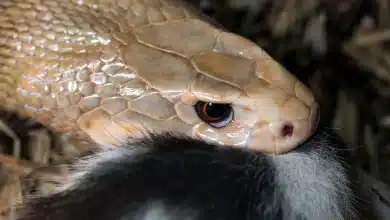Thailand Snake Photos – Malayan Blue Krait / Yellow Banded Krait

Though this photo was submitted by a guy in Borneo, Malaysia – thanks, Ryzal Manan! – this Banded Krait looks exactly as one in Thailand might look so I wanted to share the image with you.
This snake is quite deadly – and should be avoided at all costs. Yellow Banded Kraits and Malayan Blue Kraits – and the other kraits in southeast Asia tend to bite people who are sleeping on the floor or ground – or in their beds. For some reason, the kraits end up in bed with victims a lot.
The dangerous kraits can be identified rather well if they are adult because they are thicker than the wolf snakes or bridle snakes in Thailand that they resemble. A mature krait is as thick as your wrist, or a thick shovel handle. If you look at the white and black bands – you can see – they are very thick in comparison to wolf or bridle snakes – an inch or more in thickness.
However, this isn’t always a good identifier in all cases because the many-banded krait can have thinner white bands and more of them than the krait pictured above.
Be careful with any snake that looks anything like this snake!
Cheers,
Vern
Thanks again Ryzal Manan for the photo. Ryzal said this krait was seen at about 1:00 am.
Thanks too, to Tom Charlton who corrected my initial label of “Malayan Blue Krait” to “Yellow Banded Krait”. The fact that it’s white and black means little… it’s a yellow banded krait! See the high vertebral ridge? Just like the yellow-banded kraits you’ll see on this site. Tom said Borneo doesn’t have the Malayan Blue Kraits. Cheers, Tom!


Hey Vern,
this is actually a yellow banded krait, Bungarus facsiatus. The Malayan blue krait isnt found on Borneo!
Cheers, Tom
I didn’t bother to look! The high vertebral column should have been a giveaway to me – but usually I just go with the colors! Thanks Tom – will revise this.
Yes, you can distinguish them from B.canidus by the high vertebral ridge, and also that B.fasciatus also has a rather blunt tail, although this is not obvious in the photo.